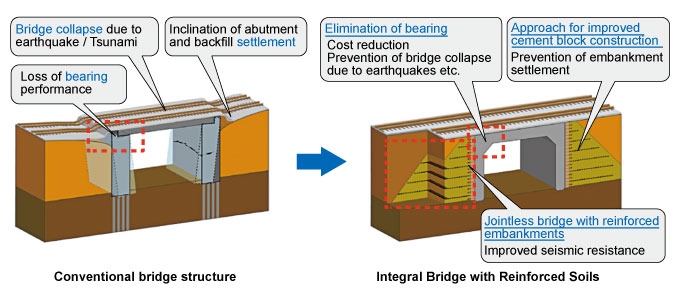1. Integral Bridge with Geosynthetic-Reinforced Soils comprising a jointless bridge with reinforced embankments
- An Integral Bridge with Geosynthetic-Reinforced Soils was developed by combining reinforced soil structures with a jointless bridge.
- Using a full scale test bridge, RTRI validated that the bridge improved continuous stability through repeated lateral loading tests taking temperature induced contraction and expansion into consideration, and cyclic lateral loading tests for level two earthquake conditions.
Conventional type bridge structures comprising girders and abutments have been found to be vulnerable to certain problems which lower their seismic resistance and overall performance, such as settlement of supporting embankments or weakening of bearings etc, in boundary areas between the embankments and the actual bridge.
In order to address this type of problem, an gIntegral Bridge with Geosynthetic-Reinforced Soilsh was developed which replaces conventional girder and abutment designs with a jointless structure with reinforced soil structures to increase the self-stability strength of the backfills. The integral bridge is expected to have higher seismic resistance, preventing embankment settlement and cracking in abutments (Fig.1).
A series of full scale model bridge tests were constructed in the RTRI embankment test centre. In addition to long term measurements taken for nearly two years, repeated lateral loading tests taking into account the thermal expansion and contraction of girders were carried out and alternating positive / negative cyclic lateral loading tests reproducing level 2 earthquake conditions were also performed, validating the new bridgefs usual and seismic resistance (Fig.2).
The new integral bridge has already been applied to the Hokkaido high speed line, and given this new bridges expected improved resistance to tidal waves, it is also being used for restoring the Sanriku railway line.
The span of the new type of bridge is the same as for RC rigid frame viaducts. The present research is funded by the Ministry for Land, Infrastructure, Transport and Tourism.

Fig.1 Conventional bridge issues and features of the Integral Bridge with Reinforced Soils.
Fig.2 Full scale model bridge of theeIntegral Bridge with Reinforced Soils'